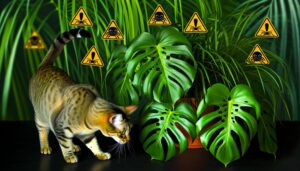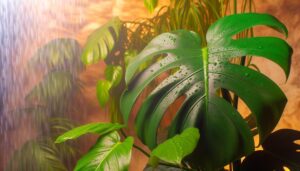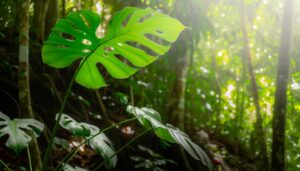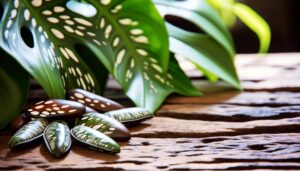Monstera Lechleriana Light Requirements
Monstera Lechleriana thrives in bright, indirect sunlight. Avoid direct sun to prevent leaf scorch, which causes unsightly brown patches.
If exposed to insufficient light, your plant may become leggy with smaller leaves. Ideal conditions include placing it near east or south-facing windows with diffused light.
Alternatively, use sheer curtains to soften intense sunlight. Monitor the plant carefully for signs of stress like yellowing or curled leaves.
A consistent 10-12 hours of light daily is essential for healthy growth. Consider grow lights in dim settings.
Keep adjusting light conditions for the best balance that ensures robust growth. Learn more about perfecting the environment above.
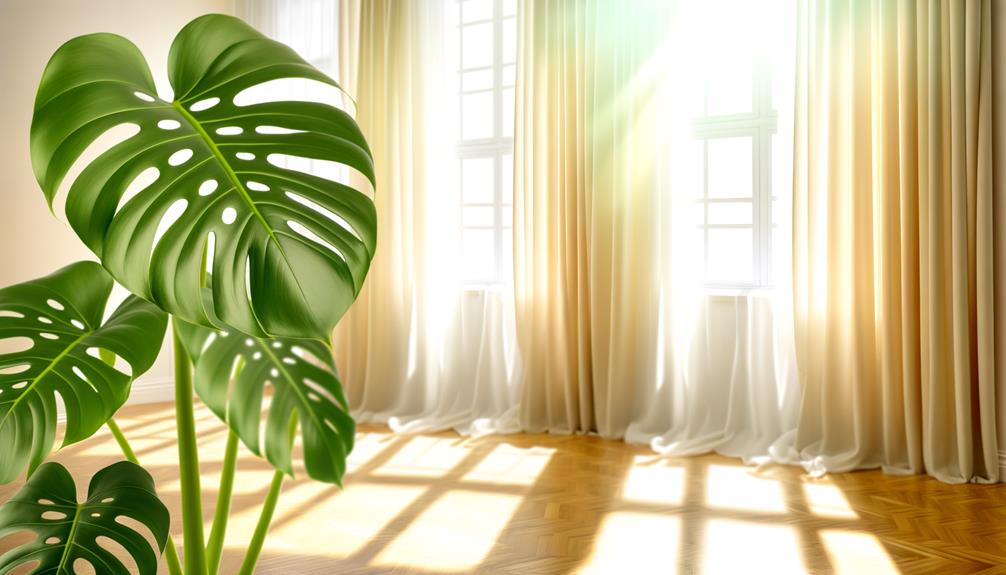
Key Takeaways
- Monstera Lechleriana thrives in bright, indirect sunlight to avoid leaf scorch.
- Avoid direct sunlight; use sheer curtains to diffuse intense light.
- Ensure 10-12 hours of consistent light daily for optimal growth.
- Consider using LED grow lights if natural light is insufficient.
- Monitor for yellowing or leggy growth as signs of inadequate light.
Understanding Light Needs
To guarantee your Monstera Lechleriana thrives, it's vital to comprehend its specific light requirements and how they impact its growth. This plant, native to tropical rainforests, needs light that mimics its natural habitat. It's important to understand that Monstera Lechleriana prefers bright, indirect sunlight.
Direct sunlight can scorch its delicate leaves, leading to unsightly brown patches. Conversely, insufficient light results in leggy growth and smaller leaves, hindering its overall health. Monitoring the light exposure is crucial; overexposure and underexposure both have adverse effects.
To optimize growth, you should aim for a balanced light environment. By grasping these nuances, you can ensure that your Monstera Lechleriana maintains its vibrant, lush appearance and robust health.
Ideal Light Conditions
For best growth, position your Monstera Lechleriana in a location where it receives bright, filtered light for most of the day. This plant thrives under steady light conditions that mimic its natural habitat. Direct sunlight can scorch the leaves, so refrain from placing it in harsh sunbeams. Instead, aim for:
- Bright, indirect light: Mimic dappled sunlight by using sheer curtains or positioning the plant near a bright window.
- Steady light exposure: Guarantee your plant gets light throughout the day to promote healthy growth.
- Avoiding low light: Inadequate light can result in leggy growth and smaller leaves.
- Moderate light adjustment: Gradually acclimate your plant to different light levels to prevent shock.
These conditions will support strong foliage and vibrant growth.
Natural Light Sources
When positioning your Monstera Lechleriana, take advantage of natural light sources like east-facing windows. These windows offer ample morning sunlight without the harshness of the afternoon sun. This orientation ensures your plant receives optimal light for photosynthesis while minimizing the risk of leaf burn.
South-facing windows can also be advantageous, but you'll need to position the plant a few feet away to prevent direct exposure to the intense midday sunlight. Approach west-facing windows with caution as they can provide strong, late-afternoon light that may stress the plant.
North-facing windows generally lack sufficient light, so consider supplementing with artificial grow lights. Always monitor your plant's response and adjust its location accordingly to maintain healthy growth.
Indirect Sunlight Benefits
Harnessing the benefits of indirect sunlight, your Monstera Lechleriana will thrive in environments where it can absorb diffused light, mimicking the dappled sunlight it naturally receives in its native tropical habitat.
Indirect light provides numerous advantages that support healthy growth and vibrant foliage. Here's why indirect sunlight is essential:
- Photosynthesis Efficiency: Diffused light optimizes photosynthesis without overwhelming the plant's chlorophyll, ensuring steady growth.
- Prevents Leaf Burn: Indirect light reduces the risk of leaf burn and discoloration, maintaining the plant's aesthetic appeal.
- Encourages Natural Growth Patterns: Mimicking natural light conditions helps your Monstera develop characteristic fenestrations and leaf splits.
- Conserves Moisture: Indirect sunlight minimizes excessive water loss through transpiration, keeping your plant hydrated.
Understanding these benefits will help you create the ideal environment for your Monstera Lechleriana.
Avoiding Direct Sunlight
Direct sunlight can cause severe harm to your Monstera Lechleriana, resulting in scorched leaves and hindered growth. You should position your plant in a spot where it receives bright, indirect light. Direct rays can lead to leaf scorch, affecting the plant's well-being. Consider using sheer curtains to diffuse sunlight or placing the plant a few feet away from the window.
Here's a quick comparison to help you understand:
| Light Condition | Impact on Monstera Lechleriana |
|---|---|
| Direct Sunlight | Leaf scorch, hindered growth |
| Indirect Sunlight | Optimum growth, vibrant foliage |
| Low Light | Slow growth, spindly stems |
| Artificial Light | Can complement natural light |
| Filtered Sunlight | Balanced growth, healthy leaves |
Keep an eye on leaf color and texture to ensure ideal light conditions.
Seasonal Light Changes
As the seasons change, the intensity and duration of natural sunlight can vary notably, affecting your Monstera Lechleriana's growth.
You'll need to adjust your indoor lighting setup to compensate for reduced daylight during winter months by using grow lights or relocating the plant to a brighter spot.
Conversely, in summer, you might need to shield it from potentially harmful direct sunlight by using sheer curtains or moving it away from windows.
Sunlight Intensity Variations
Seasonal light changes greatly impact Monstera Lechleriana, necessitating adjustments in its care routine to maintain ideal growth conditions. As sunlight intensity varies throughout the year, you must closely monitor and adapt to these shifts to guarantee your plant thrives.
- Spring and Summer: Expect more intense, longer daylight hours. This period supports vigorous growth but requires careful management to prevent leaf burn.
- Fall and Winter: Light intensity decreases, requiring adjustments to avoid stunted growth and yellowing leaves.
- Equatorial Regions: Experience relatively consistent light year-round, simplifying care routines.
- Temperate Zones: Show significant seasonal variations, requiring more frequent adjustments in plant positioning and light supplementation.
Understanding these variations helps you tailor your care regimen, optimizing Monstera Lechleriana's health and growth.
Adjusting Indoor Lighting
To guarantee Monstera Lechleriana thrives indoors despite seasonal light changes, you must strategically adjust artificial lighting to mimic natural light variations. During shorter winter days, increase the duration and intensity of your grow lights. Conversely, in brighter summer months, reduce artificial lighting to prevent overexposure. Monitoring light levels with a light meter helps optimize conditions.
| Season | Light Duration | Light Intensity |
|---|---|---|
| Winter | 10-12 hours | High |
| Spring | 8-10 hours | Medium |
| Summer | 6-8 hours | Low |
| Autumn | 8-10 hours | Medium |
Adjusting these parameters ensures your Monstera Lechleriana receives consistent, appropriate light, fostering healthy growth year-round. Regularly reassess and tweak your setup to respond to the plant's needs and seasonal shifts.
Using Grow Lights
To maximize your Monstera Lechleriana's thriving, you should use grow lights that emit a full range of light, closely mimicking natural sunlight.
Position the lights about 12-18 inches above the plant to promote peak growth and avoid leaf burn.
Adjust the light duration to 12-16 hours daily, simulating the plant's natural environment.
Optimal Light Spectrum
When using grow lights for Monstera Lechleriana, make certain the light spectrum includes both blue and red wavelengths to promote robust foliage growth and overall plant health. Blue light (400-500 nm) is crucial for photosynthesis and aids your plant in producing strong, vibrant leaves. Red light (600-700 nm) supports flowering and fruiting, even though Monstera is primarily grown for its foliage.
Consider the following tips for best light spectrum:
- Full-spectrum LED grow lights: Mimic natural sunlight, covering all necessary wavelengths.
- Adjustable spectrum settings: Allow you to customize the light mix to your plant's specific needs.
- Quality over quantity: Invest in high-grade lights to guarantee consistent performance.
- Duration control: Use timers to simulate natural day-night cycles.
Ensuring the correct light spectrum will greatly enhance your Monstera Lechleriana's growth.
Positioning for Growth
After selecting the best light spectrum for your Monstera Lechleriana, focus on positioning the grow lights to guarantee even and efficient coverage. Place the grow lights 12-18 inches above the plant to mimic natural sunlight without causing leaf burn. Use adjustable fixtures to fine-tune the height as your Monstera grows.
Make sure the light covers the entire plant, not just the top, by using a light meter to measure intensity across different areas. Rotate your Monstera weekly to encourage uniform growth. If using multiple lights, slightly overlap their coverage to avoid dark spots.
Set a timer for 12-16 hours of light daily, mimicking the natural day-night cycle, which is essential for photosynthesis and healthy development.
Light Duration and Intensity
Understanding the nuances of light duration and intensity is essential for promoting the optimal growth of Monstera Lechleriana. You need to provide your plant with bright, indirect light for around 10-12 hours daily. This light regime mimics its natural habitat, encouraging strong growth and vibrant foliage.
Key factors to keep in mind:
- Light Intensity: Aim for 200-400 lumens.
- Duration: Maintain a consistent 10-12 hours daily.
- Source: Utilize LED grow lights if natural light is insufficient.
- Adjustment: Rotate the plant periodically to ensure uniform light exposure.
Signs of Insufficient Light
When your Monstera Lechleriana isn't getting enough light, you'll notice specific signs that indicate the problem. Yellowing leaves often appear first, signaling chlorosis due to inadequate photosynthesis.
Additionally, you'll observe slow growth patterns and leggy stem development, both of which compromise the plant's overall health and structure.
Yellowing Leaves Indication
Yellowing leaves on your Monstera Lechleriana often indicate that the plant isn't getting enough light, leading to a decrease in chlorophyll production. This reduction in chlorophyll affects photosynthesis, causing leaves to lose their vibrant green color.
To address this issue, you should first evaluate the light conditions in your plant's current location.
- Insufficient light: Position the plant closer to a window with indirect sunlight.
- Softened light: Consider using sheer curtains to scatter direct sunlight.
- Artificial illumination: Supplement with grow lights if natural light is lacking.
- Rotation: Regularly rotate your plant to guarantee even light distribution.
Slow Growth Patterns
In addition to yellowing leaves, Monstera Lechleriana may exhibit slow growth patterns when it's not receiving adequate light, impacting its overall health and vigor. You'll notice fewer new leaves and minimal stem elongation. Insufficient light reduces photosynthesis, stunting growth and leading to weaker, smaller foliage. To accurately diagnose this, you can observe the following indicators:
| Indicator | Description |
|---|---|
| Leaf Production | Fewer new leaves emerging |
| Stem Elongation | Minimal to no growth in stem length |
| Foliage Size | New leaves are smaller and less robust |
Ensure your Monstera Lechleriana gets bright, indirect light for optimum growth. Without it, the plant's metabolic functions slow down, resulting in these observable symptoms.
Leggy Stem Development
You'll notice leggy stem development in your Monstera Lechleriana as a clear sign of insufficient light, characterized by elongated, sparse stems and widely spaced nodes. This condition arises when the plant stretches towards a light source, compromising its structural integrity.
To identify leggy growth, look for:
- Extended internodes: Space between leaves is abnormally long.
- Thin, weak stems: Stems appear fragile and unable to support the plant's weight.
- Paler leaves: New leaves may emerge lighter in color due to lack of chlorophyll production.
- Reduced leaf size: Leaves are smaller and fewer in number compared to healthy growth.
Signs of Excess Light
Too much light can manifest in several distinct symptoms, signaling that your Monstera Lechleriana is receiving more sunlight than it can handle. You might notice leaf burn, where the edges turn brown and crispy. Another sign is bleached leaves, which lose their vibrant green color and appear pale or yellowish. Additionally, rapid leaf curling indicates stress from excessive light. A decrease in overall plant health, including slowed growth and wilting, can also point to light issues.
| Symptom | Description |
|---|---|
| Leaf Burn | Brown, crispy edges |
| Bleached Leaves | Loss of vibrant color, turning pale |
| Leaf Curling | Leaves curling inward or downward |
| Poor Health | Stunted growth, wilting |
Light Adjustment Tips
To optimize your Monstera Lechleriana's light environment, start by gradually adjusting its position to avoid shock and ensure a steady acclimatization. Moving the plant too quickly can stress it, resulting in stunted growth or leaf burn.
Follow these steps to guarantee a smooth adjustment:
- Incremental movement: Shift the plant closer to the light source a few inches at a time over several days.
- Monitor leaf response: Check for signs of stress, such as yellowing or wilting, and adjust accordingly.
- Use sheer curtains: Diffuse direct sunlight to prevent leaf scorch while maintaining adequate light.
- Rotate regularly: Turn the plant every few days to promote even light distribution and balanced growth.
These tips will help your Monstera thrive in its new light conditions.
Maintaining Consistent Lighting Conditions
Ensuring your Monstera Lechleriana receives steady light levels involves monitoring natural light fluctuations and supplementing with artificial light sources when necessary. Track the intensity and duration of sunlight in your plant's location. Use a light meter to measure the foot-candle levels, aiming for a range between 1000-2500 foot-candles. If natural light is insufficient, employ grow lights with a spectrum between 400-700 nm.
| Light Source | Recommended Action |
|---|---|
| Natural Sunlight | Monitor daily fluctuations |
| Light Meter Readings | Aim for 1000-2500 foot-candles |
| Grow Lights | Use full-spectrum bulbs |
| Light Duration | Maintain 12-16 hours/day |
| Light Placement | Position 12-24 inches above |
Regularly adjust the light setup to adapt to seasonal changes and maintain optimal growth conditions.
Conclusion
Coincidentally, as you balance your Monstera lechleriana's light needs, you'll observe it thriving in ideal conditions.
Maintaining indirect sunlight prevents leaf burn while encouraging lush growth. If you notice yellowing leaves, it's a sign of excessive light; conversely, sparse growth indicates inadequate light.
By adjusting your plant's placement and maintaining steady lighting, you're nurturing a vibrant, healthy Monstera.
Your focus on specifics guarantees it flourishes, just like an artist perfecting their masterpiece under the appropriate light.

